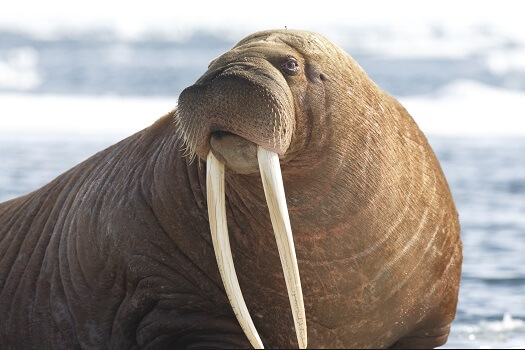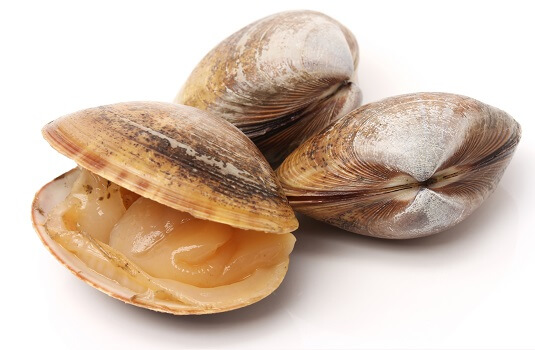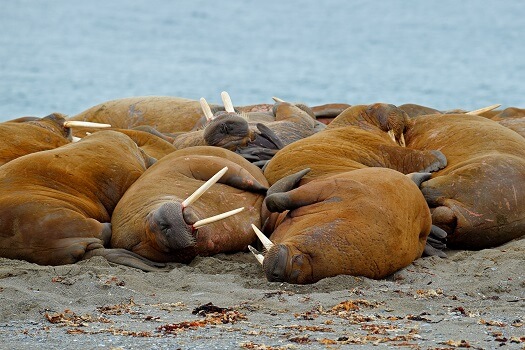
The Walrus (Odobenus rosmarus) is a large, marine mammal found in the waters of the Arctic. There are two subspecies: the Atlantic walrus (O. rosmarus rosmarus) and the Pacific walrus (O. rosmarus divergens), which are found in different areas of the Arctic. While there is insufficient data available to accurately predict their status, there is thought to be approximately 25,000 Atlantic and around 200,000 Pacific walrus left in the wild. Walruses are pinnipeds, a widely distributed and diverse clade of fin-footed, semi-aquatic mammals that also includes seals and sea lions. Walruses can reach a maximum of 12 feet (3.7 meters) in length and weigh up to 3,700 lbs (1,700 kg)! These animals display sexual dimorphism in their size as males are usually a third larger than their female counterparts. Walruses have a round-shaped head with small eyes and no external ears. They also have a short, broad muzzle that has a mustache of quill-like whiskers called vibrissae. Their grey skin is very tough and can be 1-2 inches (2-4 cm) thick. It is covered in short, reddish hair which gives the walruses an overall warm brown color. Walruses have enormous tusks! These long, upper canine teeth can grow up to 3.2 feet (one meter) in length and weigh 12 lbs (5.4kg)! Both sexes possess tusks but they are usually a lot larger in males, where they function in mating displays and defense against other walruses. The walrus’s diet is made up largely of clams and mussels, with clams being their favorite food! When they find a clam, they create a seal by putting their lips around the clam’s shell. They then create a vacuum by quickly moving their tongues to the back of their mouth. This enables them to suck the meat out of the shell. Walruses will also eat a range of fish, crustaceans, and small marine organisms. They have also been known to hunt seals and even narwhals when they become trapped by the ice. Walruses feed at shallow depths, usually between 30 – 160 feet (10 – 50 meters), using their whiskers to identify prey as they root along the ocean floor. Walruses live in herds that are usually separated by sex. They are found together on ice floes and on land where they live in groups that can contain hundreds of animals. This can increase to thousands during the mating season. When the mating season begins, male walruses will fight to dominate a harem of females. Males will mate with many females, but a female will only mate with one male. The gestation period lasts around 15 months, with the females giving birth between April and June. Walrus calves can weigh up to 165 lbs (75 kg)! The calves are immediately able to swim. The mothers nurse their calves for over a year and the calves stay with their mothers for up to five years. Walruses run on all fours like a dog and can move surprisingly quickly on land. Their speed can match that of a running human. Unfortunately, walruses are known to startle easily, which can trigger a stampede. When walruses are gathered in such large numbers this can result in members of its herd getting crushed to death. Climate change is the biggest threat facing walruses today. Melting sea ice is affecting both the Arctic and Pacific populations but in different ways. Arctic walruses are at a greater threat of disturbance due to more shipping, tourism, and industry which is increasing noise and the risk of stampedes. For Pacific walruses, melting sea ice is forcing more walruses on to land. Not only is this further from their feeding grounds but it results in more walruses being found in one area. As these animals are easily spooked, these large groups put some walruses, especially young calves, at risk of death from stampedes. Walruses are also hunted by polar bears, killer whales, and humans. The walrus is a large marine mammal that is famous for its mustache and long, ivory tusks. This pinniped is found throughout the cold waters of the Arctic and has several biological adaptations that help it survive here. Once overhunted for its hide and its tusks, walrus populations are today somewhat protected, although accurate information on their population numbers is unavailable. Let’s take a closer look at this magnificent animal! Walruses live in some of the harshest conditions on earth. They spend most of their time in cold waters, where they lose heat 27 times faster than they do on land. Yet, the walrus maintains its body heat, and its metabolism is unaffected by exposure to the cold. Walruses have great insulation that takes the form of a layer of fat called blubber. Blubber is found just under the skin and it keeps the walrus warm while helping to streamline their body and provide them with energy when they need it most. This layer of fat can reach up to 3.9 inches (10cm) thick and can make up to one-third of the walrus’s weight in the winter months! Blubber is an important adaptation that several marine mammals have to help them cope with their cold environments. Walruses were hunted for their hides and their tusks as they were worth a lot of money. Their tusks, which are made of ivory, were particularly sought after. While limited numbers are still hunted in the United States, Canada, Greenland, and Russia, they used to be commercially hunted which had great impacts on their numbers. Scientists recently discovered that a special breed of walruses used to be found in Iceland but became extinct around the year 1100. These walrus populations were previously thought to be part of the larger populations found further north, but by examining mitochondrial DNA from the walrus remains they were able to deduce that these animals belonged to a separate subspecies. Research suggests that humans were responsible for this animal going extinct and that it represents one of the first cases of humans having devasting impacts on marine wildlife. Settlers in Iceland would have used the walrus’s hide for clothing, as well as for rope that was used on the settlers’ boats. Walrus oil was used to provide insulation as well as ward off crustaceans that could cause damage to the hulls of the ships. Calvings were also made from their tusks and were often gifted to kings. A walrus doesn’t have external ear flaps like most mammals, but instead, the ears are two small openings with protective flaps. The lack of external ears is an adaptation to the cold, as it reduces the external appendages and the area of skin through which heat can be lost. A walrus’s ears are hard to see as they are often hidden by their skin folds. Their ears function the same in water as they do on land. The walrus’s ear has remarkable morphological adaptations that make them unique in the mammalian world. A walrus’s outer ear is completely embedded in blubber and covered by thick skin. Also, the middle ear cavity is extremely large and lined with vascularized tissue, elastic fibers, and collagen tissue. The base of the outer ear and the entire middle and inner ear are also surrounded by dense bones. A walrus has remarkable hearing and can detect sounds up to a mile away (1.6 km).
Kingdom
Animalia
Phylum
Chordata
Class
Mammalia
Order
Carnivora
Family
Odobenidae
Genus
Odobenus
Species
Odobenus rosmarus
Length
6.6 – 11.5 feet (2 – 3.5 meters)
Weight
1,764 – 2,646 pounds (800 – 1,200 kg)
Lifespan
Up to 40 years in the wild
Social Structure
Live in herds
Status
Insufficient data
Habitat
The cold waters of the Arctic
Average litter size
1 calf every 2 – 3 years
Main food item
Shellfish, Fish, squid, crustaceans, and seals
Main predators
Polar bears, killer whales, and humans
The Basics

Walruses can be Social

Fun Facts about the Walrus!
Blubber
Icelandic Walrus

No External Ears
